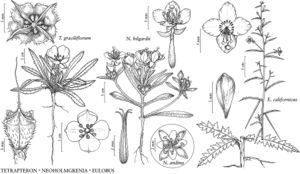Eulobus californicus
Fl. N. Amer. 1: 515. 1840.
Herbs sparsely strigillose, sometimes also sparsely glandular puberulent, especially on leaves and inflorescences. Stems erect, virgate, bluish green and often glaucescent, or bright green, thick, hollow, fleshy, 2–180 cm. Leaves in a well-defined basal rosette, usually withered by anthesis, and also cauline; basal 2.5–10(–30) × 0.6–2.5(–6.5) cm, petiole 0–6 cm, blade narrowly elliptic, margins irregularly pinnatifid; cauline very much reduced distally, 1–8 × (0.1–)0.3–1(–1.6) cm, petiole 0–3 cm, blade narrowly elliptic, margins irregularly pinnatifid. Flowers opening at sunrise; floral tube 0.6–1.5 mm, closed by a conspicuous rounded, fleshy, reddish brown disc; sepals reddish green, 3.9–8 mm; petals ± with fine, red flecking at base, 6–14 mm; episepalous filaments 3–9 mm, epipetalous filaments 2–5 mm, anthers of longer stamens 1–2.5 mm, those of shorter stamens 0.5–1.2 mm; style 4–10 mm, stigma globose, 0.8–2 mm diam., surrounded by anthers of longer stamens at anthesis. Capsules sharply reflexed at maturity, cylindrical fresh, 4-angled dry, (45–)60–110 × 1–1.2 mm. Seeds olive brown, often flecked with purple dots, 1.3–1.6 × 0.5–0.7 mm. 2n = 14, 28.
Phenology: Flowering Dec–May.
Habitat: Open places in coastal sage scrub, chaparral, desert scrub, valley grasslands, foothill woodlands, washes, flats, loose soils.
Elevation: 0–1300 m.
Distribution
Ariz., Calif., Mexico (Baja California, Sonora).
Discussion
Eulobus californicus is known from western and southern Arizona, central and southern California, as well as from adjacent areas of northwestern Mexico.
P. H. Raven (1969) determined that Eulobus californicus is self-compatible and primarily autogamous. Known diploid (2n = 14) populations are all in California.
Selected References
None.
